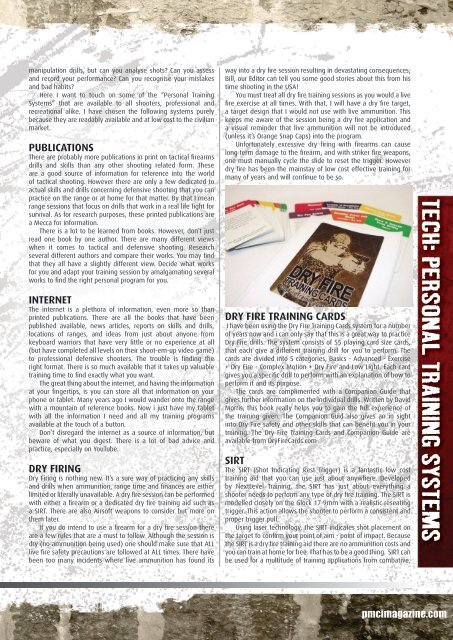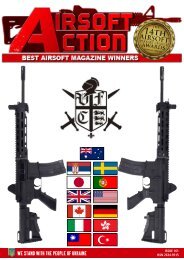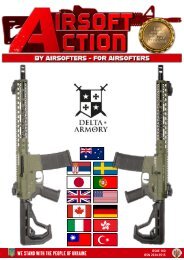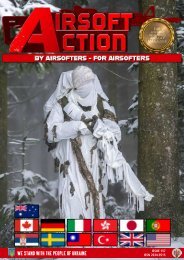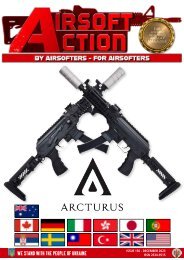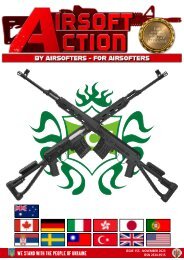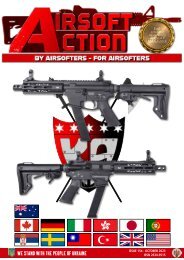PMCI - January 2018
Welcome to the first issue of PMCI for 2018 and we're kicking off with two very special reports! First up we speak to a man who has made the protection of our endangered species his mission and he tells us all about working "hands on" with a first rate anti-poaching team in Africa. Trampas also brings us a great interview with some top gunsmiths in the USA and asks them "what does the future hold" for the industry and for their very special creations. With yet more focus on equipment and training, there's a great new year ahead for the PMCI Team and for you, our readers!
Welcome to the first issue of PMCI for 2018 and we're kicking off with two very special reports!
First up we speak to a man who has made the protection of our endangered species his mission and he tells us all about working "hands on" with a first rate anti-poaching team in Africa. Trampas also brings us a great interview with some top gunsmiths in the USA and asks them "what does the future hold" for the industry and for their very special creations.
With yet more focus on equipment and training, there's a great new year ahead for the PMCI Team and for you, our readers!
Create successful ePaper yourself
Turn your PDF publications into a flip-book with our unique Google optimized e-Paper software.
manipulation drills, but can you analyse shots? Can you assess<br />
and record your performance? Can you recognise your mistakes<br />
and bad habits?<br />
Here I want to touch on some of the “Personal Training<br />
Systems” that are available to all shooters, professional and<br />
recreational alike. I have chosen the following systems purely<br />
because they are readably available and at low cost to the civilian<br />
market.<br />
PUBLICATIONS<br />
There are probably more publications in print on tactical firearms<br />
drills and skills than any other shooting related form. These<br />
are a good source of information for reference into the world<br />
of tactical shooting. However there are only a few dedicated to<br />
actual skills and drills concerning defensive shooting that you can<br />
practice on the range or at home for that matter. By that I mean<br />
range sessions that focus on drills that work in a real life fight for<br />
survival. As for research purposes, these printed publications are<br />
a Mecca for information.<br />
There is a lot to be learned from books. However, don’t just<br />
read one book by one author. There are many different views<br />
when it comes to tactical and defensive shooting. Research<br />
several different authors and compare their works. You may find<br />
that they all have a slightly different view. Decide what works<br />
for you and adapt your training session by amalgamating several<br />
works to find the right personal program for you.<br />
INTERNET<br />
The internet is a plethora of information, even more so than<br />
printed publications. There are all the books that have been<br />
published available, news articles, reports on skills and drills,<br />
locations of ranges, and ideas from just about anyone from<br />
keyboard warriors that have very little or no experience at all<br />
(but have completed all levels on their shoot-em-up video game)<br />
to professional defensive shooters. The trouble is finding the<br />
right format. There is so much available that it takes up valuable<br />
training time to find exactly what you want.<br />
The great thing about the internet, and having the information<br />
at your fingertips, is you can store all that information on your<br />
phone or tablet. Many years ago I would wander onto the range<br />
with a mountain of reference books. Now i just have my tablet<br />
with all the information I need and all my training programs<br />
available at the touch of a button.<br />
Don’t disregard the internet as a source of information, but<br />
beware of what you digest. There is a lot of bad advice and<br />
practice, especially on YouTube.<br />
DRY FIRING<br />
Dry Firing is nothing new. It’s a sure way of practicing any skills<br />
and drills when ammunition, range time and finances are either<br />
limited or literally unavailable. A dry fire session can be performed<br />
with either a firearm or a dedicated dry fire training aid such as<br />
a SIRT. There are also Airsoft weapons to consider but more on<br />
them later.<br />
If you do intend to use a firearm for a dry fire session there<br />
are a few rules that are a must to follow. Although the session is<br />
dry (no ammunition being used) one should make sure that ALL<br />
live fire safety precautions are followed at ALL times. There have<br />
been too many incidents where live ammunition has found its<br />
way into a dry fire session resulting in devastating consequences;<br />
Bill, our Editor can tell you some good stories about this from his<br />
time shooting in the USA!<br />
You must treat all dry fire training sessions as you would a live<br />
fire exercise at all times. With that, I will have a dry fire target,<br />
a target design that I would not use with live ammunition. This<br />
keeps me aware of the session being a dry fire application and<br />
a visual reminder that live ammunition will not be introduced<br />
(unless it’s Orange Snap Caps) into the program.<br />
Unfortunately excessive dry firing with firearms can cause<br />
long term damage to the firearm, and with striker fire weapons,<br />
one must manually cycle the slide to reset the trigger. However<br />
dry fire has been the mainstay of low cost effective training for<br />
many of years and will continue to be so.<br />
DRY FIRE TRAINING CARDS<br />
I have been using the Dry Fire Training Cards system for a number<br />
of years now and i can only say that this is a great way to practice<br />
Dry Fire drills. The system consists of 55 playing card size cards,<br />
that each give a different training drill for you to perform. The<br />
cards are divided into 5 categories, Basics - Advanced - Exercise<br />
+ Dry Fire - Complex Motion + Dry Fire and Low Light. Each card<br />
gives you a specific drill to perform with an explanation of how to<br />
perform it and its purpose.<br />
The cards are complimented with a Companion Guide that<br />
gives further information on the individual drills. Written by David<br />
Morris, this book really helps you to gain the full experience of<br />
the training given. The Companion Guid also gives an in sight<br />
into Dry Fire safety and other skills that can benefit you in your<br />
training. The Dry Fire Training Cards and Companion Guide are<br />
available from DryFireCards.com<br />
SIRT<br />
The SIRT (Shot Indicating Rest Trigger) is a fantastic low cost<br />
training aid that you can use just about anywhere. Developed<br />
by NextLevel Training, the SIRT has just about everything a<br />
shooter needs to perform any type of dry fire training. The SIRT is<br />
modelled closely on the Glock 17 9mm with a realistic reseating<br />
trigger. This action allows the shooter to perform a consistent and<br />
proper trigger pull.<br />
Using laser technology, the SIRT indicates shot placement on<br />
the target to confirm your point of aim - point of impact. Because<br />
the SIRT is a dry fire training aid there are no ammunition costs and<br />
you can train at home for free. That has to be a good thing. SIRT can<br />
be used for a multitude of training applications from combative,<br />
TECH: PERSONAL TRAINING SYSTEMS<br />
pmcimagazine.com


